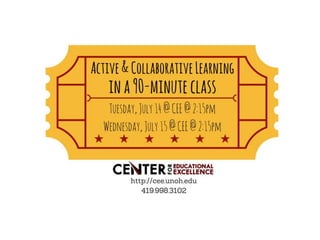
CEE Summer Series Active and Collaborative Learning
- 2. Does this describe us? Is this the best way to teach…? Do we really want to do this for an hour-and-a-half…? Image: “Cartoon angry army drill sergeant shouting” by koiquest10 is licensed under CC BY-SA 2.0.
- 3. Definition • “Collaborative learning’ is an umbrella term for a variety of educational approaches involving joint intellectual effort by students, or students and teachers together. In most collaborative learning situations students are working in groups of two or more, mutually searching for understanding, solutions, or meanings, or creating a product” (Smith & MacGregor, 1992, p. 10) Smith, B. L. , & MacGregor, J. T. (1992). What is collaborative learning? In A. Goodsell , M. Maher, & V. Tinto (Eds.), Collaborative learning: A sourcebook for higher education (pp. 10-36), University Park, PA: National Center on Post-Secondary Teaching, Learning, and Assessment
- 4. Supported by Neuroscience Research Neuroscience research has shown that we grown neural connections through experience and learning. Behaviors that are practiced and rehearsed strengthen those connections. Connections that are not used are pruned away. We are physically changing the structure of our brains when we engage in active learning! Image: “brain” by tza is licensed under CC BY-NC 2.0.
- 5. Cognitive Theory/ Constructivist Philosophy Cognitive theory (Piaget, for example) suggests that we learn by actively making connections and organizing them into meaningful concepts—we learn best when we actively integrate new information into existing concepts and ideas Photo: “Integration” by certified_su is licensed under CC BY 2.0.
- 6. Scaffolding/Zone of Proximal Development Russian social-learning theorist Lev Vygotsky introduced the term “zone of proximal development” (essentially, what the learner cannot do on their own and what they can do with help). Collaborative learning activities provide opportunities for students to learn material within their grasp by working with other more capable peers. Photo: “Workers remove scaffolding from the Commander, Fleet Activities Yokusuka headquarters building” by usnavy is licensed under CC BY 2.0.
- 7. Learning by Imitation Social Cognitive theorist Albert Bandura demonstrated that we can learn by watching and imitating others— particularly others whom we perceive as similar to ourselves on certain dimensions and capabilities (classmates/group members, etc.). Photo: “best friend mama” by swambo is licensed under CC BY-SA 4.0.
- 8. Seeking Understanding Activities that are designed to challenge students to interact with others while trying to reinterpret and make meaning out of knowledge promotes deeper learning. Learning can be fun, but good learning—learning that is meaningful and lasting isn’t automatic or passive. It requires effort (cost?) from professors and students. Photo: “Group Discussion” by erlhamcollege is licensed under CC BY-NC 2.0
- 9. Final Quote: “If there is one thing that the literature agrees on universally, it is the value of involving the learner in the active processing of incoming information” (p. 190) -William McKeachie Svinicki, M. & McKeachie, W. J. (2011). McKeachie’s teaching tips: Strategies, research, and theory for college and university teachers
- 10. Brainstorm/Discussion • Describe a concept, course goal, or lesson objective you would like to turn into a collaborative activity. Initiate discussion using COLT #1: Think-Pair-Share (pp. 153-158)—use Think-Pair-Square variation.
- 11. Brainstorm/Discussion Results • How might you convert the concept, course goal, or lesson objective you just identified into something more active or collaborative? Use COLT #3: Buzz Groups (pp. 164-169) – break into several groups.
- 12. Identify Something that Could Work For You! Use COLT #31: Team Scavenger Hunt (pp. 336-341)—use information scavenger hunt variation with resources in the room. Working in pairs (?) participants locate something that might be useful for their purposes. Find something specific (or at least identify a resource that would be helpful). Photo: “Co-Creation Day #3” by timsamoff is licensed under CC BY-ND 2.0.
- 13. CEE Resources to assist you: Angelo, T.A., Cross, P.K., (1993). Classroom Assessment Techniques: A handbook for college teachers (2nd ed.). San Francisco, CA: Jossey-Bass. Barkely, E. F. (2010). Student engagement techniques: A handbook for college faculty. San Francisco, CA: Jossey-Bass. Barkley, E. F., Cross, P. K., & Major, C. H. (2014). Collaborative learning techniques: A handbook for college faculty (2nd ed.). San Francisco, CA: Jossey-Bass. Svinicki, M. & McKeachie, W. J. (2011). McKeachie’s teaching tips: Strategies, research, and theory for college and university teachers, (13th ed.). Belmont, CA: Wadsworth.
- 14. A Few Web-based Resources Cornell University’s Center for Teaching Excellence • http://www.cte.cornell.edu/teaching-ideas/engaging- students/collaborative-learning.html PDF file from Educause (includes lots of additional web-links) • http://net.educause.edu/ir/library/pdf/eli80085.pdf Vanderbilt University’s Center for Teaching • http://cft.vanderbilt.edu/guides-sub-pages/cooperative- learning/ University of Maryland’s Center for Teaching Excellence • http://www.cte.umd.edu/library/teachingLargeClass/guide/ch 7.html